Blended Learning Design Proposal for IT Students in NZ Education
VerifiedAdded on 2022/08/24
|25
|8058
|169
Project
AI Summary
This project presents a comprehensive design proposal for implementing blended learning activities tailored for IT students within New Zealand educational institutions. The proposal emphasizes the integration of traditional classroom settings with online learning resources to create a comprehensive learning module. The study delves into virtual learning scenarios, emerging technologies like digital storytelling and gamification, and a review of existing blended learning models. The proposal focuses on the New Zealand context, considering the country's three-tiered education system and the high standards of its universities. The aim is to create a framework that leverages the strengths of both traditional and digital learning environments, enhancing student engagement and outcomes. The project also acknowledges the importance of understanding the specific needs of students, classrooms, and institutional activities in New Zealand to ensure the effectiveness of the blended learning approach. The design proposal considers the customizable nature of blended learning to cater to the unique requirements of the New Zealand educational landscape.
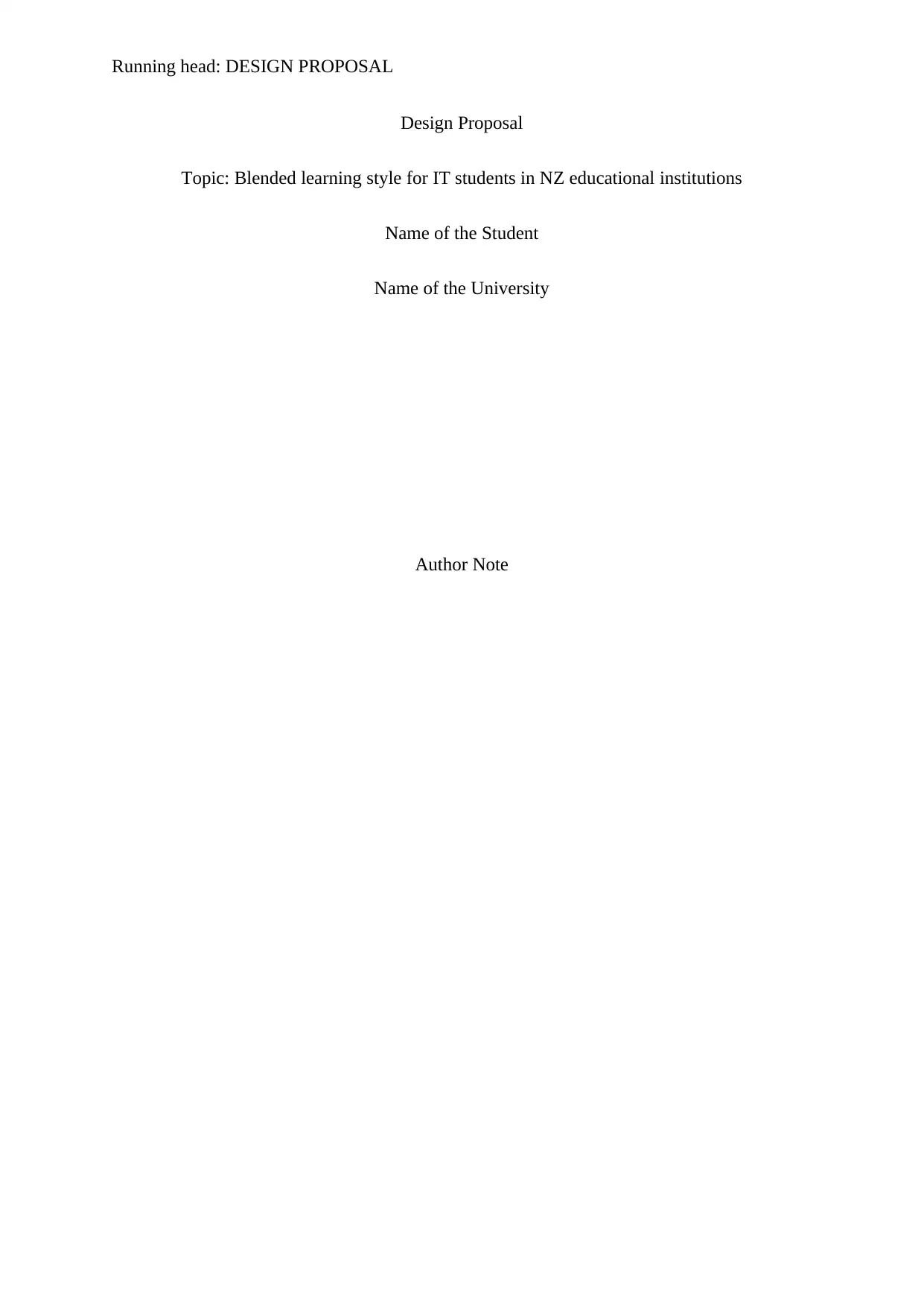
Running head: DESIGN PROPOSAL
Design Proposal
Topic: Blended learning style for IT students in NZ educational institutions
Name of the Student
Name of the University
Author Note
Design Proposal
Topic: Blended learning style for IT students in NZ educational institutions
Name of the Student
Name of the University
Author Note
Paraphrase This Document
Need a fresh take? Get an instant paraphrase of this document with our AI Paraphraser
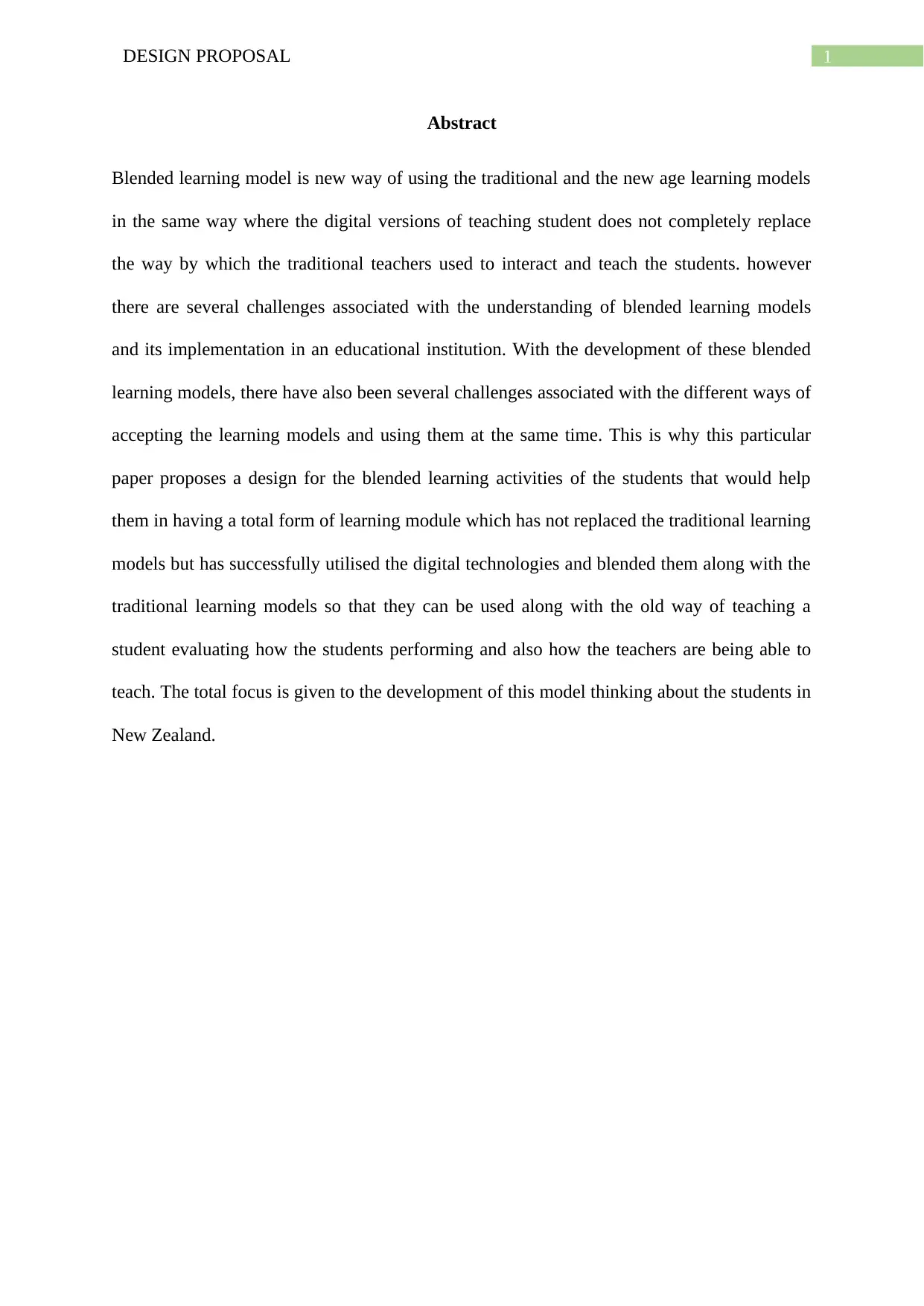
1DESIGN PROPOSAL
Abstract
Blended learning model is new way of using the traditional and the new age learning models
in the same way where the digital versions of teaching student does not completely replace
the way by which the traditional teachers used to interact and teach the students. however
there are several challenges associated with the understanding of blended learning models
and its implementation in an educational institution. With the development of these blended
learning models, there have also been several challenges associated with the different ways of
accepting the learning models and using them at the same time. This is why this particular
paper proposes a design for the blended learning activities of the students that would help
them in having a total form of learning module which has not replaced the traditional learning
models but has successfully utilised the digital technologies and blended them along with the
traditional learning models so that they can be used along with the old way of teaching a
student evaluating how the students performing and also how the teachers are being able to
teach. The total focus is given to the development of this model thinking about the students in
New Zealand.
Abstract
Blended learning model is new way of using the traditional and the new age learning models
in the same way where the digital versions of teaching student does not completely replace
the way by which the traditional teachers used to interact and teach the students. however
there are several challenges associated with the understanding of blended learning models
and its implementation in an educational institution. With the development of these blended
learning models, there have also been several challenges associated with the different ways of
accepting the learning models and using them at the same time. This is why this particular
paper proposes a design for the blended learning activities of the students that would help
them in having a total form of learning module which has not replaced the traditional learning
models but has successfully utilised the digital technologies and blended them along with the
traditional learning models so that they can be used along with the old way of teaching a
student evaluating how the students performing and also how the teachers are being able to
teach. The total focus is given to the development of this model thinking about the students in
New Zealand.
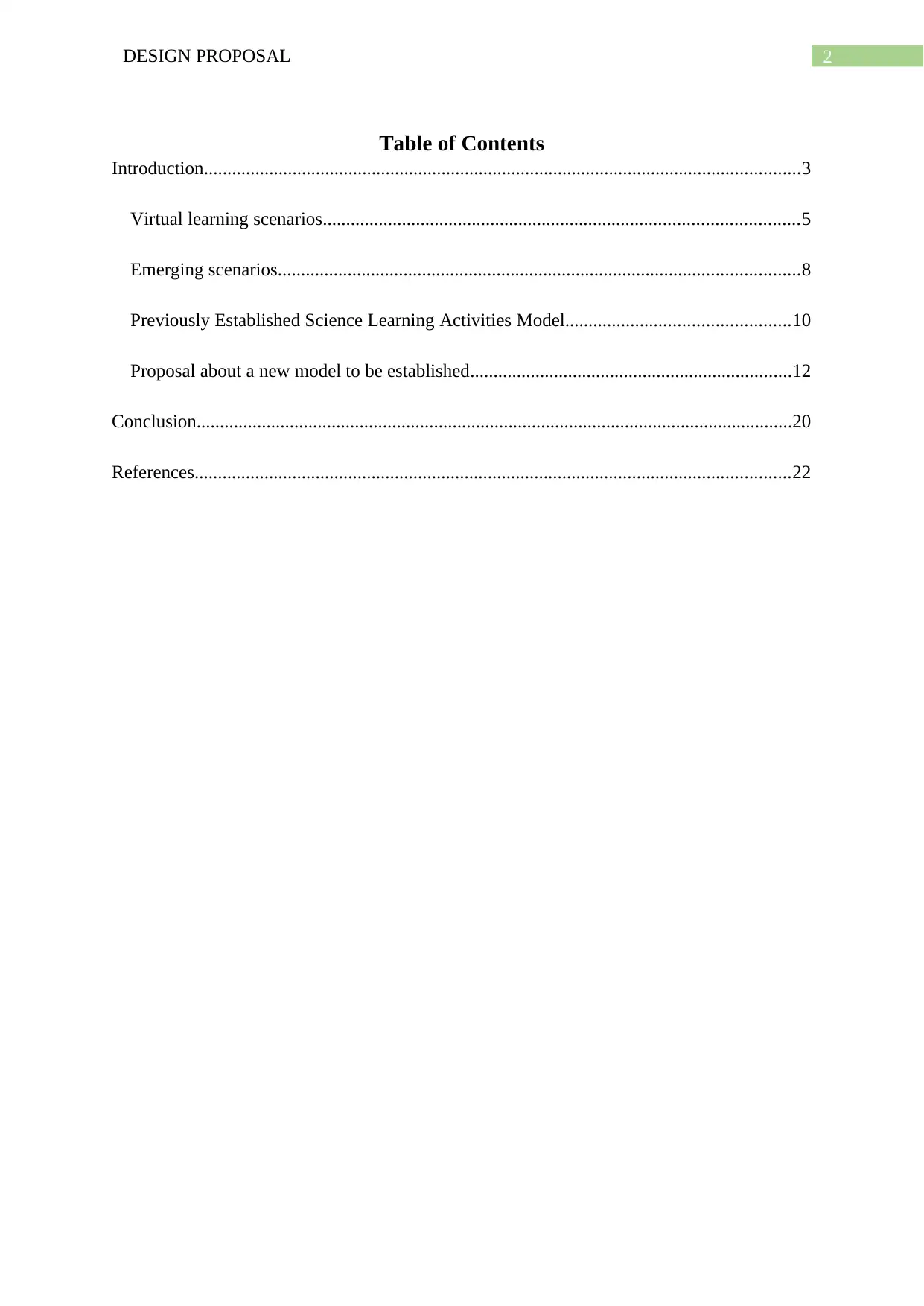
2DESIGN PROPOSAL
Table of Contents
Introduction................................................................................................................................3
Virtual learning scenarios......................................................................................................5
Emerging scenarios................................................................................................................8
Previously Established Science Learning Activities Model................................................10
Proposal about a new model to be established.....................................................................12
Conclusion................................................................................................................................20
References................................................................................................................................22
Table of Contents
Introduction................................................................................................................................3
Virtual learning scenarios......................................................................................................5
Emerging scenarios................................................................................................................8
Previously Established Science Learning Activities Model................................................10
Proposal about a new model to be established.....................................................................12
Conclusion................................................................................................................................20
References................................................................................................................................22
⊘ This is a preview!⊘
Do you want full access?
Subscribe today to unlock all pages.

Trusted by 1+ million students worldwide
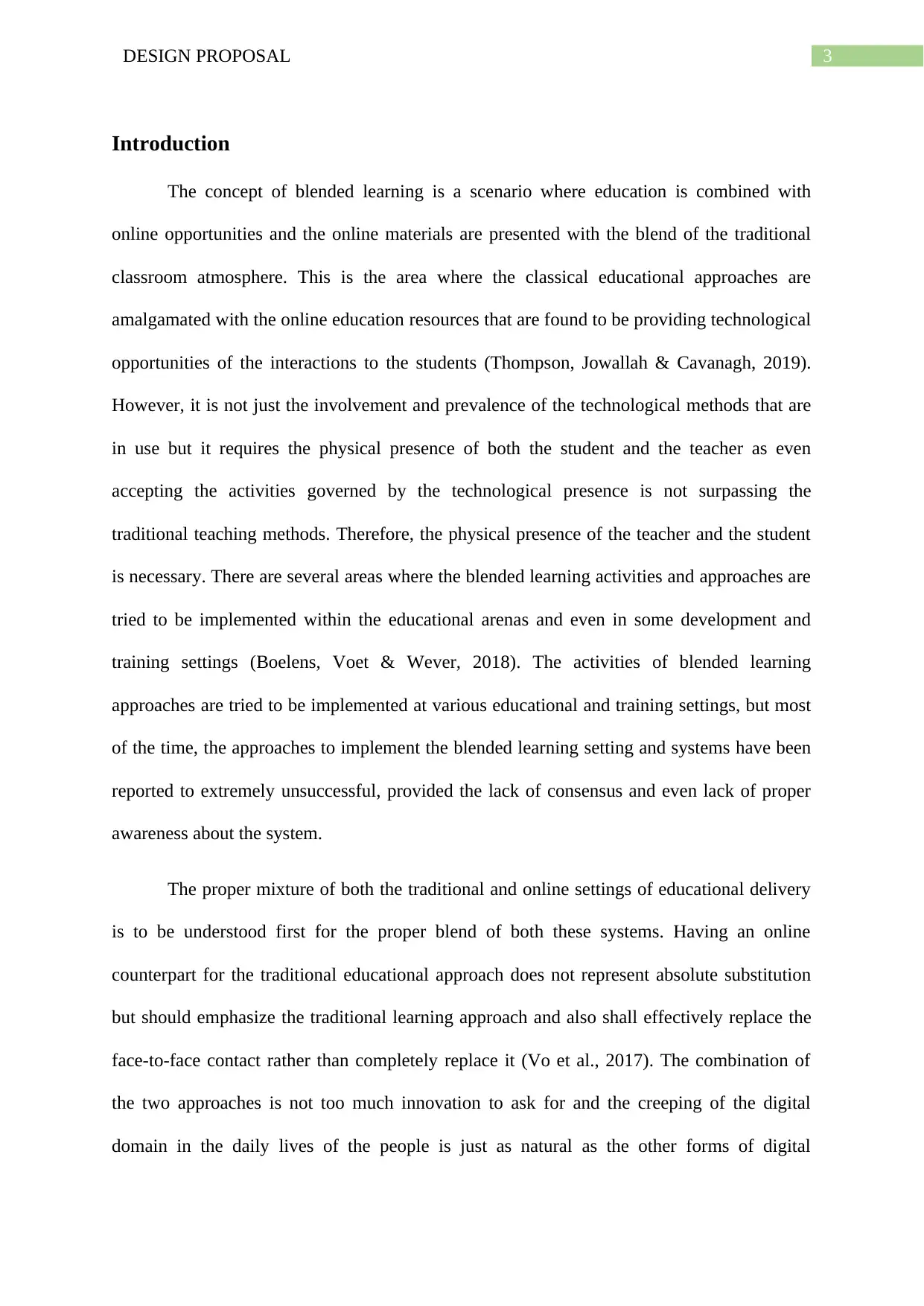
3DESIGN PROPOSAL
Introduction
The concept of blended learning is a scenario where education is combined with
online opportunities and the online materials are presented with the blend of the traditional
classroom atmosphere. This is the area where the classical educational approaches are
amalgamated with the online education resources that are found to be providing technological
opportunities of the interactions to the students (Thompson, Jowallah & Cavanagh, 2019).
However, it is not just the involvement and prevalence of the technological methods that are
in use but it requires the physical presence of both the student and the teacher as even
accepting the activities governed by the technological presence is not surpassing the
traditional teaching methods. Therefore, the physical presence of the teacher and the student
is necessary. There are several areas where the blended learning activities and approaches are
tried to be implemented within the educational arenas and even in some development and
training settings (Boelens, Voet & Wever, 2018). The activities of blended learning
approaches are tried to be implemented at various educational and training settings, but most
of the time, the approaches to implement the blended learning setting and systems have been
reported to extremely unsuccessful, provided the lack of consensus and even lack of proper
awareness about the system.
The proper mixture of both the traditional and online settings of educational delivery
is to be understood first for the proper blend of both these systems. Having an online
counterpart for the traditional educational approach does not represent absolute substitution
but should emphasize the traditional learning approach and also shall effectively replace the
face-to-face contact rather than completely replace it (Vo et al., 2017). The combination of
the two approaches is not too much innovation to ask for and the creeping of the digital
domain in the daily lives of the people is just as natural as the other forms of digital
Introduction
The concept of blended learning is a scenario where education is combined with
online opportunities and the online materials are presented with the blend of the traditional
classroom atmosphere. This is the area where the classical educational approaches are
amalgamated with the online education resources that are found to be providing technological
opportunities of the interactions to the students (Thompson, Jowallah & Cavanagh, 2019).
However, it is not just the involvement and prevalence of the technological methods that are
in use but it requires the physical presence of both the student and the teacher as even
accepting the activities governed by the technological presence is not surpassing the
traditional teaching methods. Therefore, the physical presence of the teacher and the student
is necessary. There are several areas where the blended learning activities and approaches are
tried to be implemented within the educational arenas and even in some development and
training settings (Boelens, Voet & Wever, 2018). The activities of blended learning
approaches are tried to be implemented at various educational and training settings, but most
of the time, the approaches to implement the blended learning setting and systems have been
reported to extremely unsuccessful, provided the lack of consensus and even lack of proper
awareness about the system.
The proper mixture of both the traditional and online settings of educational delivery
is to be understood first for the proper blend of both these systems. Having an online
counterpart for the traditional educational approach does not represent absolute substitution
but should emphasize the traditional learning approach and also shall effectively replace the
face-to-face contact rather than completely replace it (Vo et al., 2017). The combination of
the two approaches is not too much innovation to ask for and the creeping of the digital
domain in the daily lives of the people is just as natural as the other forms of digital
Paraphrase This Document
Need a fresh take? Get an instant paraphrase of this document with our AI Paraphraser
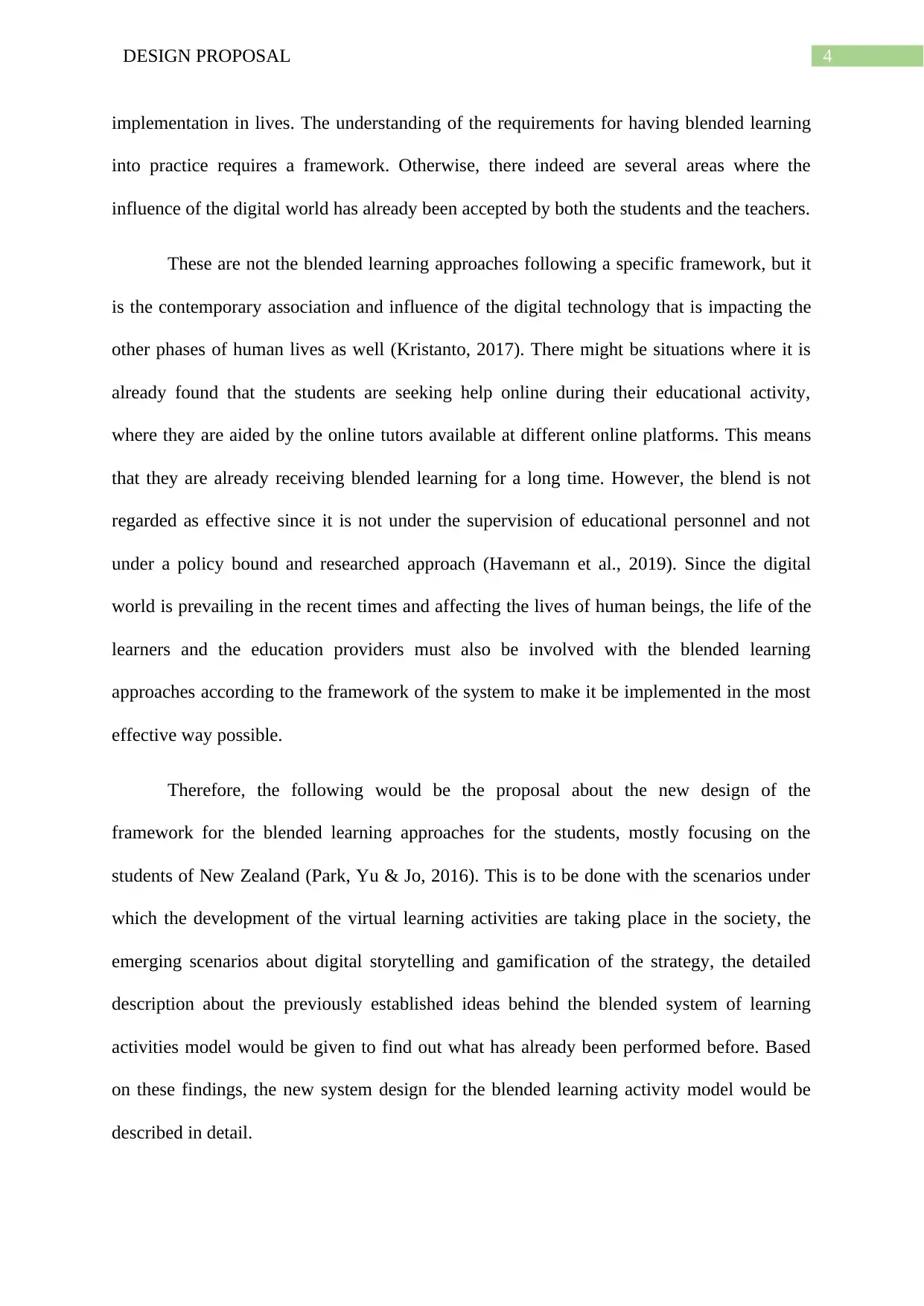
4DESIGN PROPOSAL
implementation in lives. The understanding of the requirements for having blended learning
into practice requires a framework. Otherwise, there indeed are several areas where the
influence of the digital world has already been accepted by both the students and the teachers.
These are not the blended learning approaches following a specific framework, but it
is the contemporary association and influence of the digital technology that is impacting the
other phases of human lives as well (Kristanto, 2017). There might be situations where it is
already found that the students are seeking help online during their educational activity,
where they are aided by the online tutors available at different online platforms. This means
that they are already receiving blended learning for a long time. However, the blend is not
regarded as effective since it is not under the supervision of educational personnel and not
under a policy bound and researched approach (Havemann et al., 2019). Since the digital
world is prevailing in the recent times and affecting the lives of human beings, the life of the
learners and the education providers must also be involved with the blended learning
approaches according to the framework of the system to make it be implemented in the most
effective way possible.
Therefore, the following would be the proposal about the new design of the
framework for the blended learning approaches for the students, mostly focusing on the
students of New Zealand (Park, Yu & Jo, 2016). This is to be done with the scenarios under
which the development of the virtual learning activities are taking place in the society, the
emerging scenarios about digital storytelling and gamification of the strategy, the detailed
description about the previously established ideas behind the blended system of learning
activities model would be given to find out what has already been performed before. Based
on these findings, the new system design for the blended learning activity model would be
described in detail.
implementation in lives. The understanding of the requirements for having blended learning
into practice requires a framework. Otherwise, there indeed are several areas where the
influence of the digital world has already been accepted by both the students and the teachers.
These are not the blended learning approaches following a specific framework, but it
is the contemporary association and influence of the digital technology that is impacting the
other phases of human lives as well (Kristanto, 2017). There might be situations where it is
already found that the students are seeking help online during their educational activity,
where they are aided by the online tutors available at different online platforms. This means
that they are already receiving blended learning for a long time. However, the blend is not
regarded as effective since it is not under the supervision of educational personnel and not
under a policy bound and researched approach (Havemann et al., 2019). Since the digital
world is prevailing in the recent times and affecting the lives of human beings, the life of the
learners and the education providers must also be involved with the blended learning
approaches according to the framework of the system to make it be implemented in the most
effective way possible.
Therefore, the following would be the proposal about the new design of the
framework for the blended learning approaches for the students, mostly focusing on the
students of New Zealand (Park, Yu & Jo, 2016). This is to be done with the scenarios under
which the development of the virtual learning activities are taking place in the society, the
emerging scenarios about digital storytelling and gamification of the strategy, the detailed
description about the previously established ideas behind the blended system of learning
activities model would be given to find out what has already been performed before. Based
on these findings, the new system design for the blended learning activity model would be
described in detail.
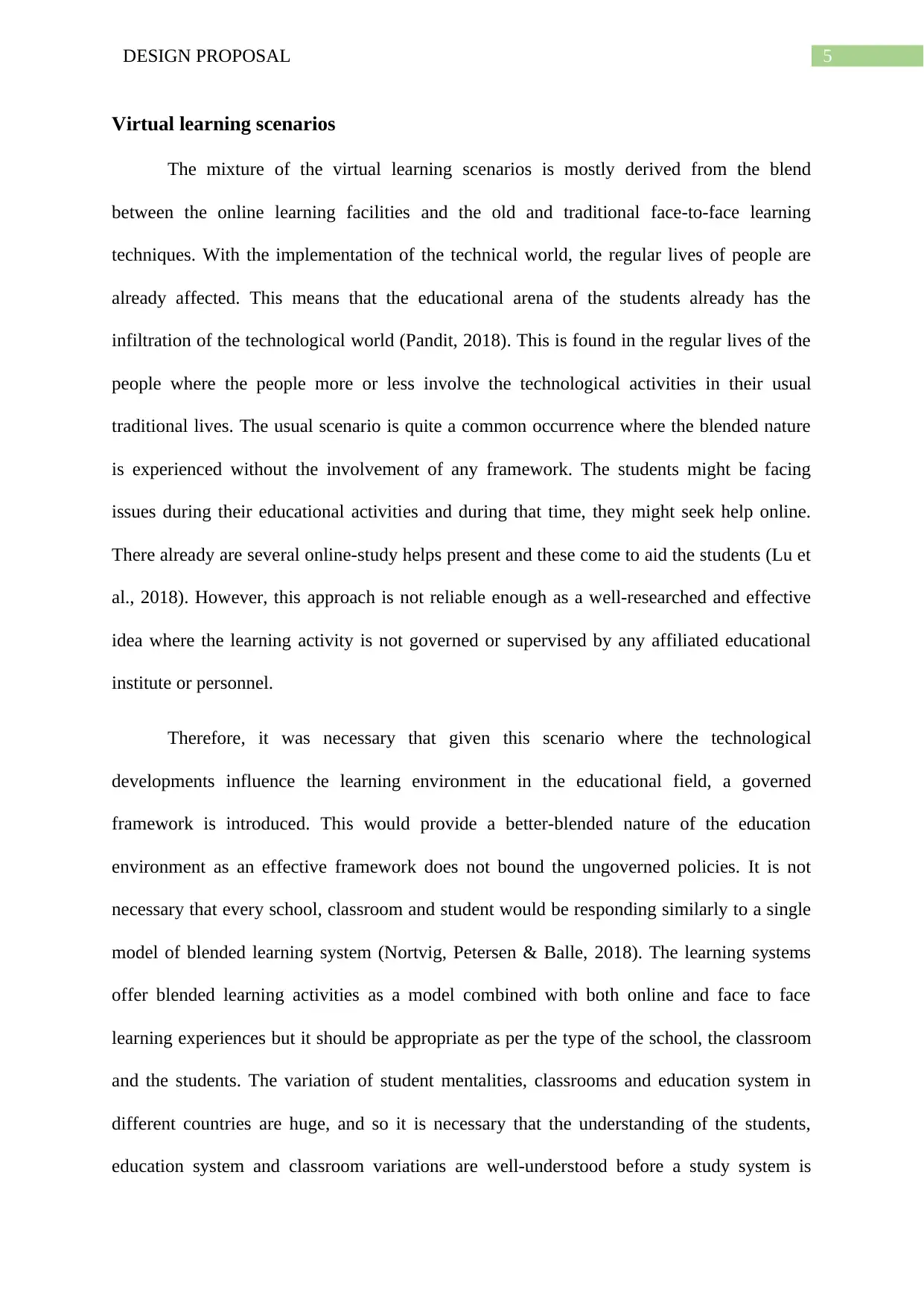
5DESIGN PROPOSAL
Virtual learning scenarios
The mixture of the virtual learning scenarios is mostly derived from the blend
between the online learning facilities and the old and traditional face-to-face learning
techniques. With the implementation of the technical world, the regular lives of people are
already affected. This means that the educational arena of the students already has the
infiltration of the technological world (Pandit, 2018). This is found in the regular lives of the
people where the people more or less involve the technological activities in their usual
traditional lives. The usual scenario is quite a common occurrence where the blended nature
is experienced without the involvement of any framework. The students might be facing
issues during their educational activities and during that time, they might seek help online.
There already are several online-study helps present and these come to aid the students (Lu et
al., 2018). However, this approach is not reliable enough as a well-researched and effective
idea where the learning activity is not governed or supervised by any affiliated educational
institute or personnel.
Therefore, it was necessary that given this scenario where the technological
developments influence the learning environment in the educational field, a governed
framework is introduced. This would provide a better-blended nature of the education
environment as an effective framework does not bound the ungoverned policies. It is not
necessary that every school, classroom and student would be responding similarly to a single
model of blended learning system (Nortvig, Petersen & Balle, 2018). The learning systems
offer blended learning activities as a model combined with both online and face to face
learning experiences but it should be appropriate as per the type of the school, the classroom
and the students. The variation of student mentalities, classrooms and education system in
different countries are huge, and so it is necessary that the understanding of the students,
education system and classroom variations are well-understood before a study system is
Virtual learning scenarios
The mixture of the virtual learning scenarios is mostly derived from the blend
between the online learning facilities and the old and traditional face-to-face learning
techniques. With the implementation of the technical world, the regular lives of people are
already affected. This means that the educational arena of the students already has the
infiltration of the technological world (Pandit, 2018). This is found in the regular lives of the
people where the people more or less involve the technological activities in their usual
traditional lives. The usual scenario is quite a common occurrence where the blended nature
is experienced without the involvement of any framework. The students might be facing
issues during their educational activities and during that time, they might seek help online.
There already are several online-study helps present and these come to aid the students (Lu et
al., 2018). However, this approach is not reliable enough as a well-researched and effective
idea where the learning activity is not governed or supervised by any affiliated educational
institute or personnel.
Therefore, it was necessary that given this scenario where the technological
developments influence the learning environment in the educational field, a governed
framework is introduced. This would provide a better-blended nature of the education
environment as an effective framework does not bound the ungoverned policies. It is not
necessary that every school, classroom and student would be responding similarly to a single
model of blended learning system (Nortvig, Petersen & Balle, 2018). The learning systems
offer blended learning activities as a model combined with both online and face to face
learning experiences but it should be appropriate as per the type of the school, the classroom
and the students. The variation of student mentalities, classrooms and education system in
different countries are huge, and so it is necessary that the understanding of the students,
education system and classroom variations are well-understood before a study system is
⊘ This is a preview!⊘
Do you want full access?
Subscribe today to unlock all pages.

Trusted by 1+ million students worldwide
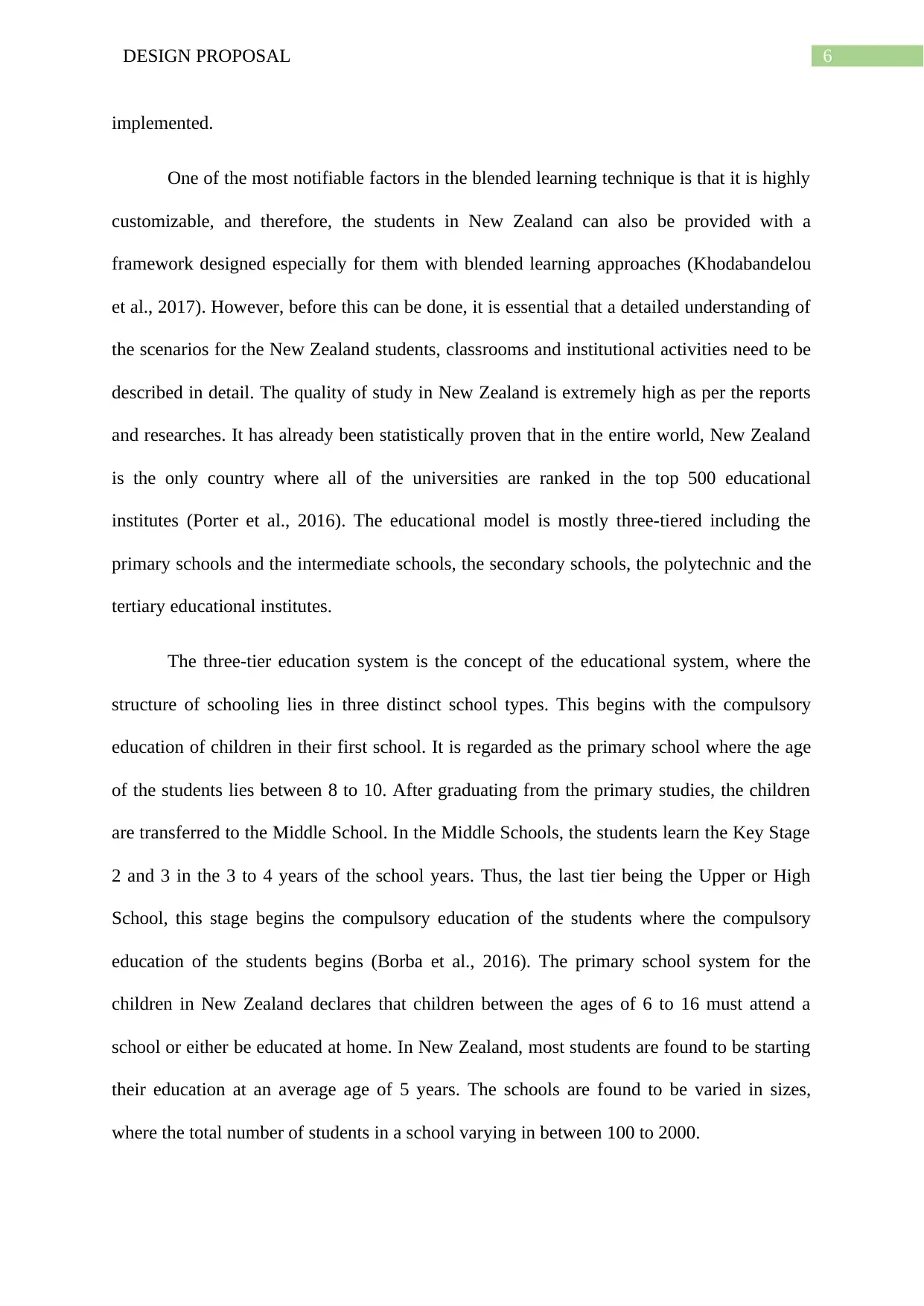
6DESIGN PROPOSAL
implemented.
One of the most notifiable factors in the blended learning technique is that it is highly
customizable, and therefore, the students in New Zealand can also be provided with a
framework designed especially for them with blended learning approaches (Khodabandelou
et al., 2017). However, before this can be done, it is essential that a detailed understanding of
the scenarios for the New Zealand students, classrooms and institutional activities need to be
described in detail. The quality of study in New Zealand is extremely high as per the reports
and researches. It has already been statistically proven that in the entire world, New Zealand
is the only country where all of the universities are ranked in the top 500 educational
institutes (Porter et al., 2016). The educational model is mostly three-tiered including the
primary schools and the intermediate schools, the secondary schools, the polytechnic and the
tertiary educational institutes.
The three-tier education system is the concept of the educational system, where the
structure of schooling lies in three distinct school types. This begins with the compulsory
education of children in their first school. It is regarded as the primary school where the age
of the students lies between 8 to 10. After graduating from the primary studies, the children
are transferred to the Middle School. In the Middle Schools, the students learn the Key Stage
2 and 3 in the 3 to 4 years of the school years. Thus, the last tier being the Upper or High
School, this stage begins the compulsory education of the students where the compulsory
education of the students begins (Borba et al., 2016). The primary school system for the
children in New Zealand declares that children between the ages of 6 to 16 must attend a
school or either be educated at home. In New Zealand, most students are found to be starting
their education at an average age of 5 years. The schools are found to be varied in sizes,
where the total number of students in a school varying in between 100 to 2000.
implemented.
One of the most notifiable factors in the blended learning technique is that it is highly
customizable, and therefore, the students in New Zealand can also be provided with a
framework designed especially for them with blended learning approaches (Khodabandelou
et al., 2017). However, before this can be done, it is essential that a detailed understanding of
the scenarios for the New Zealand students, classrooms and institutional activities need to be
described in detail. The quality of study in New Zealand is extremely high as per the reports
and researches. It has already been statistically proven that in the entire world, New Zealand
is the only country where all of the universities are ranked in the top 500 educational
institutes (Porter et al., 2016). The educational model is mostly three-tiered including the
primary schools and the intermediate schools, the secondary schools, the polytechnic and the
tertiary educational institutes.
The three-tier education system is the concept of the educational system, where the
structure of schooling lies in three distinct school types. This begins with the compulsory
education of children in their first school. It is regarded as the primary school where the age
of the students lies between 8 to 10. After graduating from the primary studies, the children
are transferred to the Middle School. In the Middle Schools, the students learn the Key Stage
2 and 3 in the 3 to 4 years of the school years. Thus, the last tier being the Upper or High
School, this stage begins the compulsory education of the students where the compulsory
education of the students begins (Borba et al., 2016). The primary school system for the
children in New Zealand declares that children between the ages of 6 to 16 must attend a
school or either be educated at home. In New Zealand, most students are found to be starting
their education at an average age of 5 years. The schools are found to be varied in sizes,
where the total number of students in a school varying in between 100 to 2000.
Paraphrase This Document
Need a fresh take? Get an instant paraphrase of this document with our AI Paraphraser
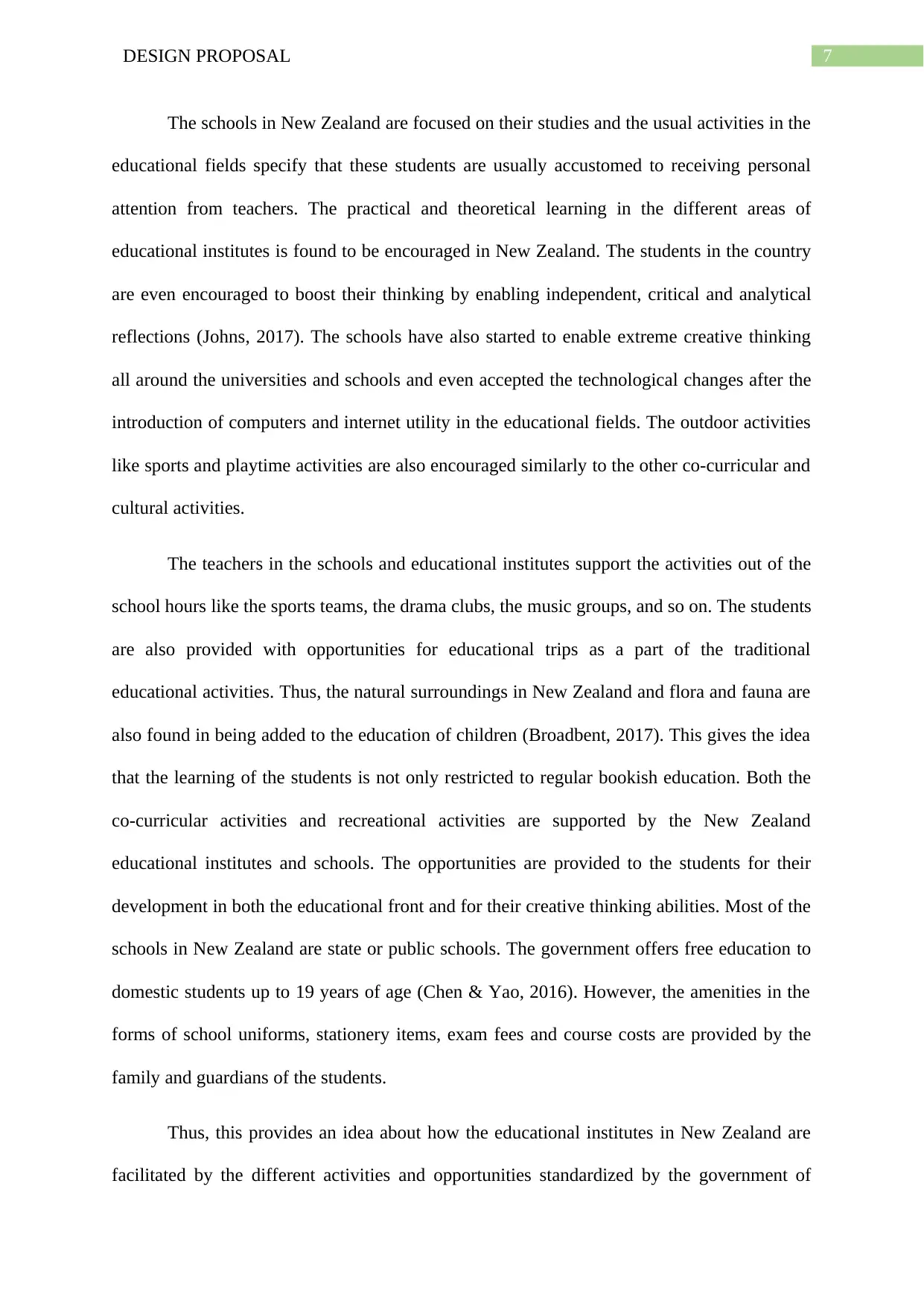
7DESIGN PROPOSAL
The schools in New Zealand are focused on their studies and the usual activities in the
educational fields specify that these students are usually accustomed to receiving personal
attention from teachers. The practical and theoretical learning in the different areas of
educational institutes is found to be encouraged in New Zealand. The students in the country
are even encouraged to boost their thinking by enabling independent, critical and analytical
reflections (Johns, 2017). The schools have also started to enable extreme creative thinking
all around the universities and schools and even accepted the technological changes after the
introduction of computers and internet utility in the educational fields. The outdoor activities
like sports and playtime activities are also encouraged similarly to the other co-curricular and
cultural activities.
The teachers in the schools and educational institutes support the activities out of the
school hours like the sports teams, the drama clubs, the music groups, and so on. The students
are also provided with opportunities for educational trips as a part of the traditional
educational activities. Thus, the natural surroundings in New Zealand and flora and fauna are
also found in being added to the education of children (Broadbent, 2017). This gives the idea
that the learning of the students is not only restricted to regular bookish education. Both the
co-curricular activities and recreational activities are supported by the New Zealand
educational institutes and schools. The opportunities are provided to the students for their
development in both the educational front and for their creative thinking abilities. Most of the
schools in New Zealand are state or public schools. The government offers free education to
domestic students up to 19 years of age (Chen & Yao, 2016). However, the amenities in the
forms of school uniforms, stationery items, exam fees and course costs are provided by the
family and guardians of the students.
Thus, this provides an idea about how the educational institutes in New Zealand are
facilitated by the different activities and opportunities standardized by the government of
The schools in New Zealand are focused on their studies and the usual activities in the
educational fields specify that these students are usually accustomed to receiving personal
attention from teachers. The practical and theoretical learning in the different areas of
educational institutes is found to be encouraged in New Zealand. The students in the country
are even encouraged to boost their thinking by enabling independent, critical and analytical
reflections (Johns, 2017). The schools have also started to enable extreme creative thinking
all around the universities and schools and even accepted the technological changes after the
introduction of computers and internet utility in the educational fields. The outdoor activities
like sports and playtime activities are also encouraged similarly to the other co-curricular and
cultural activities.
The teachers in the schools and educational institutes support the activities out of the
school hours like the sports teams, the drama clubs, the music groups, and so on. The students
are also provided with opportunities for educational trips as a part of the traditional
educational activities. Thus, the natural surroundings in New Zealand and flora and fauna are
also found in being added to the education of children (Broadbent, 2017). This gives the idea
that the learning of the students is not only restricted to regular bookish education. Both the
co-curricular activities and recreational activities are supported by the New Zealand
educational institutes and schools. The opportunities are provided to the students for their
development in both the educational front and for their creative thinking abilities. Most of the
schools in New Zealand are state or public schools. The government offers free education to
domestic students up to 19 years of age (Chen & Yao, 2016). However, the amenities in the
forms of school uniforms, stationery items, exam fees and course costs are provided by the
family and guardians of the students.
Thus, this provides an idea about how the educational institutes in New Zealand are
facilitated by the different activities and opportunities standardized by the government of
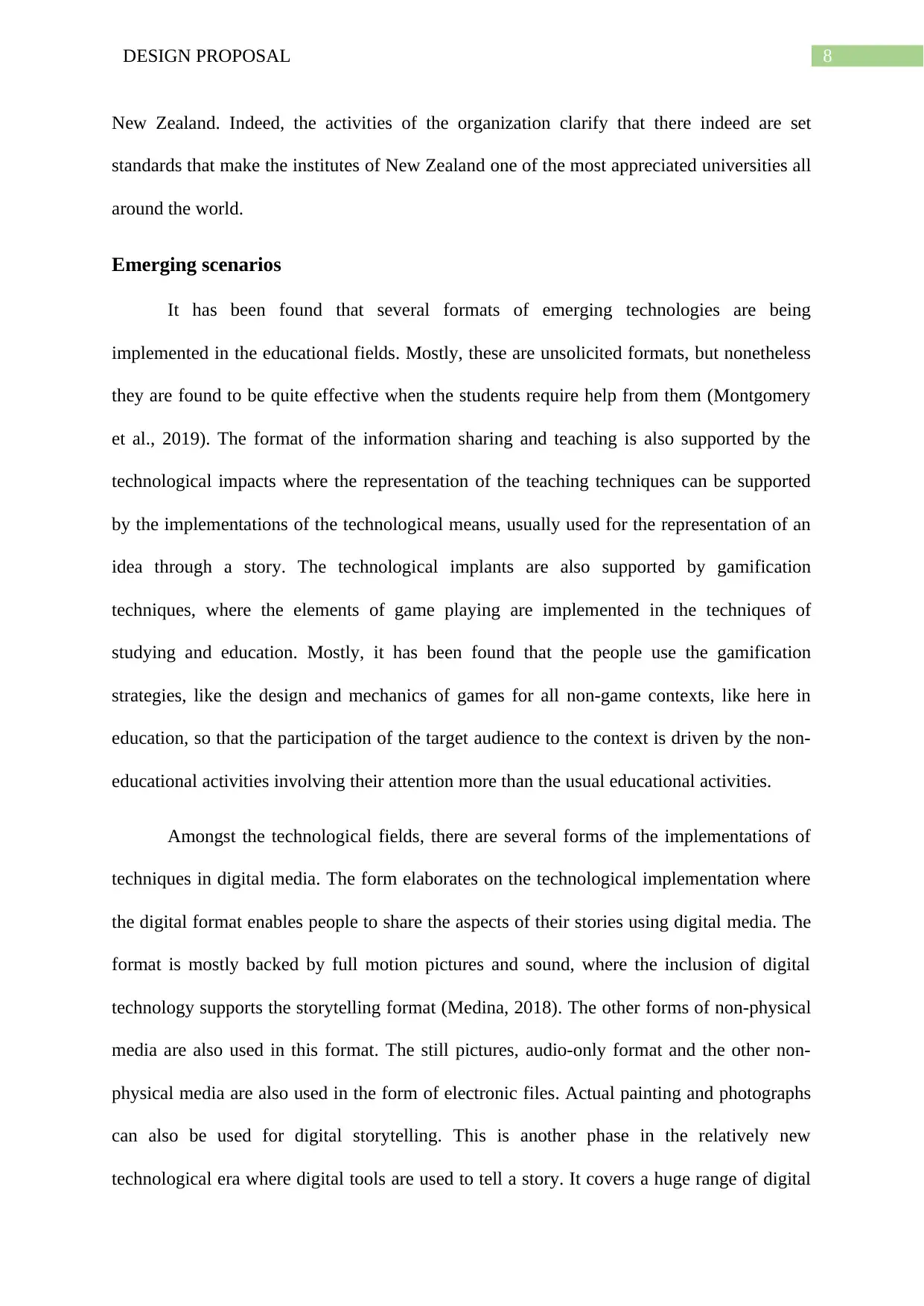
8DESIGN PROPOSAL
New Zealand. Indeed, the activities of the organization clarify that there indeed are set
standards that make the institutes of New Zealand one of the most appreciated universities all
around the world.
Emerging scenarios
It has been found that several formats of emerging technologies are being
implemented in the educational fields. Mostly, these are unsolicited formats, but nonetheless
they are found to be quite effective when the students require help from them (Montgomery
et al., 2019). The format of the information sharing and teaching is also supported by the
technological impacts where the representation of the teaching techniques can be supported
by the implementations of the technological means, usually used for the representation of an
idea through a story. The technological implants are also supported by gamification
techniques, where the elements of game playing are implemented in the techniques of
studying and education. Mostly, it has been found that the people use the gamification
strategies, like the design and mechanics of games for all non-game contexts, like here in
education, so that the participation of the target audience to the context is driven by the non-
educational activities involving their attention more than the usual educational activities.
Amongst the technological fields, there are several forms of the implementations of
techniques in digital media. The form elaborates on the technological implementation where
the digital format enables people to share the aspects of their stories using digital media. The
format is mostly backed by full motion pictures and sound, where the inclusion of digital
technology supports the storytelling format (Medina, 2018). The other forms of non-physical
media are also used in this format. The still pictures, audio-only format and the other non-
physical media are also used in the form of electronic files. Actual painting and photographs
can also be used for digital storytelling. This is another phase in the relatively new
technological era where digital tools are used to tell a story. It covers a huge range of digital
New Zealand. Indeed, the activities of the organization clarify that there indeed are set
standards that make the institutes of New Zealand one of the most appreciated universities all
around the world.
Emerging scenarios
It has been found that several formats of emerging technologies are being
implemented in the educational fields. Mostly, these are unsolicited formats, but nonetheless
they are found to be quite effective when the students require help from them (Montgomery
et al., 2019). The format of the information sharing and teaching is also supported by the
technological impacts where the representation of the teaching techniques can be supported
by the implementations of the technological means, usually used for the representation of an
idea through a story. The technological implants are also supported by gamification
techniques, where the elements of game playing are implemented in the techniques of
studying and education. Mostly, it has been found that the people use the gamification
strategies, like the design and mechanics of games for all non-game contexts, like here in
education, so that the participation of the target audience to the context is driven by the non-
educational activities involving their attention more than the usual educational activities.
Amongst the technological fields, there are several forms of the implementations of
techniques in digital media. The form elaborates on the technological implementation where
the digital format enables people to share the aspects of their stories using digital media. The
format is mostly backed by full motion pictures and sound, where the inclusion of digital
technology supports the storytelling format (Medina, 2018). The other forms of non-physical
media are also used in this format. The still pictures, audio-only format and the other non-
physical media are also used in the form of electronic files. Actual painting and photographs
can also be used for digital storytelling. This is another phase in the relatively new
technological era where digital tools are used to tell a story. It covers a huge range of digital
⊘ This is a preview!⊘
Do you want full access?
Subscribe today to unlock all pages.

Trusted by 1+ million students worldwide
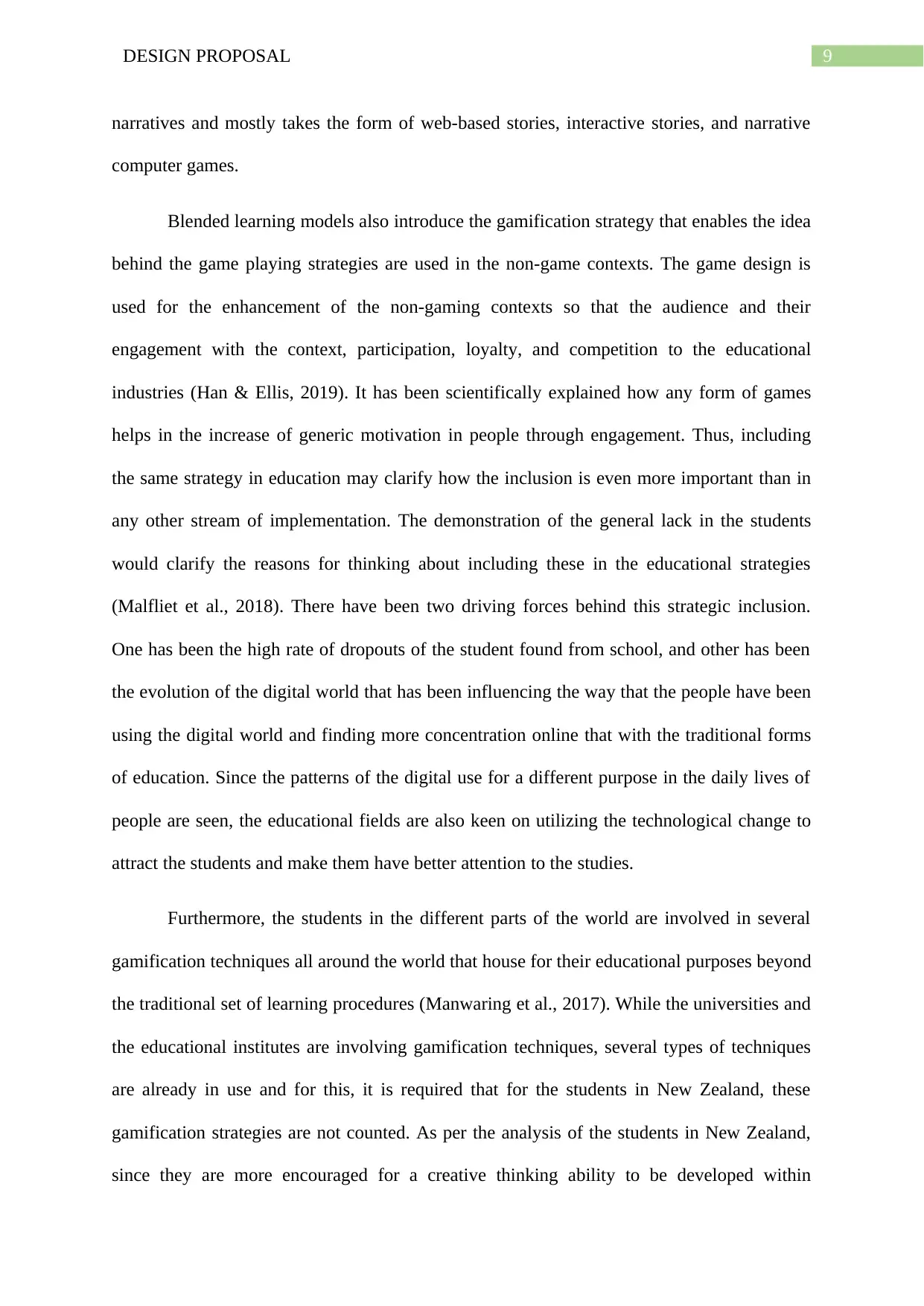
9DESIGN PROPOSAL
narratives and mostly takes the form of web-based stories, interactive stories, and narrative
computer games.
Blended learning models also introduce the gamification strategy that enables the idea
behind the game playing strategies are used in the non-game contexts. The game design is
used for the enhancement of the non-gaming contexts so that the audience and their
engagement with the context, participation, loyalty, and competition to the educational
industries (Han & Ellis, 2019). It has been scientifically explained how any form of games
helps in the increase of generic motivation in people through engagement. Thus, including
the same strategy in education may clarify how the inclusion is even more important than in
any other stream of implementation. The demonstration of the general lack in the students
would clarify the reasons for thinking about including these in the educational strategies
(Malfliet et al., 2018). There have been two driving forces behind this strategic inclusion.
One has been the high rate of dropouts of the student found from school, and other has been
the evolution of the digital world that has been influencing the way that the people have been
using the digital world and finding more concentration online that with the traditional forms
of education. Since the patterns of the digital use for a different purpose in the daily lives of
people are seen, the educational fields are also keen on utilizing the technological change to
attract the students and make them have better attention to the studies.
Furthermore, the students in the different parts of the world are involved in several
gamification techniques all around the world that house for their educational purposes beyond
the traditional set of learning procedures (Manwaring et al., 2017). While the universities and
the educational institutes are involving gamification techniques, several types of techniques
are already in use and for this, it is required that for the students in New Zealand, these
gamification strategies are not counted. As per the analysis of the students in New Zealand,
since they are more encouraged for a creative thinking ability to be developed within
narratives and mostly takes the form of web-based stories, interactive stories, and narrative
computer games.
Blended learning models also introduce the gamification strategy that enables the idea
behind the game playing strategies are used in the non-game contexts. The game design is
used for the enhancement of the non-gaming contexts so that the audience and their
engagement with the context, participation, loyalty, and competition to the educational
industries (Han & Ellis, 2019). It has been scientifically explained how any form of games
helps in the increase of generic motivation in people through engagement. Thus, including
the same strategy in education may clarify how the inclusion is even more important than in
any other stream of implementation. The demonstration of the general lack in the students
would clarify the reasons for thinking about including these in the educational strategies
(Malfliet et al., 2018). There have been two driving forces behind this strategic inclusion.
One has been the high rate of dropouts of the student found from school, and other has been
the evolution of the digital world that has been influencing the way that the people have been
using the digital world and finding more concentration online that with the traditional forms
of education. Since the patterns of the digital use for a different purpose in the daily lives of
people are seen, the educational fields are also keen on utilizing the technological change to
attract the students and make them have better attention to the studies.
Furthermore, the students in the different parts of the world are involved in several
gamification techniques all around the world that house for their educational purposes beyond
the traditional set of learning procedures (Manwaring et al., 2017). While the universities and
the educational institutes are involving gamification techniques, several types of techniques
are already in use and for this, it is required that for the students in New Zealand, these
gamification strategies are not counted. As per the analysis of the students in New Zealand,
since they are more encouraged for a creative thinking ability to be developed within
Paraphrase This Document
Need a fresh take? Get an instant paraphrase of this document with our AI Paraphraser
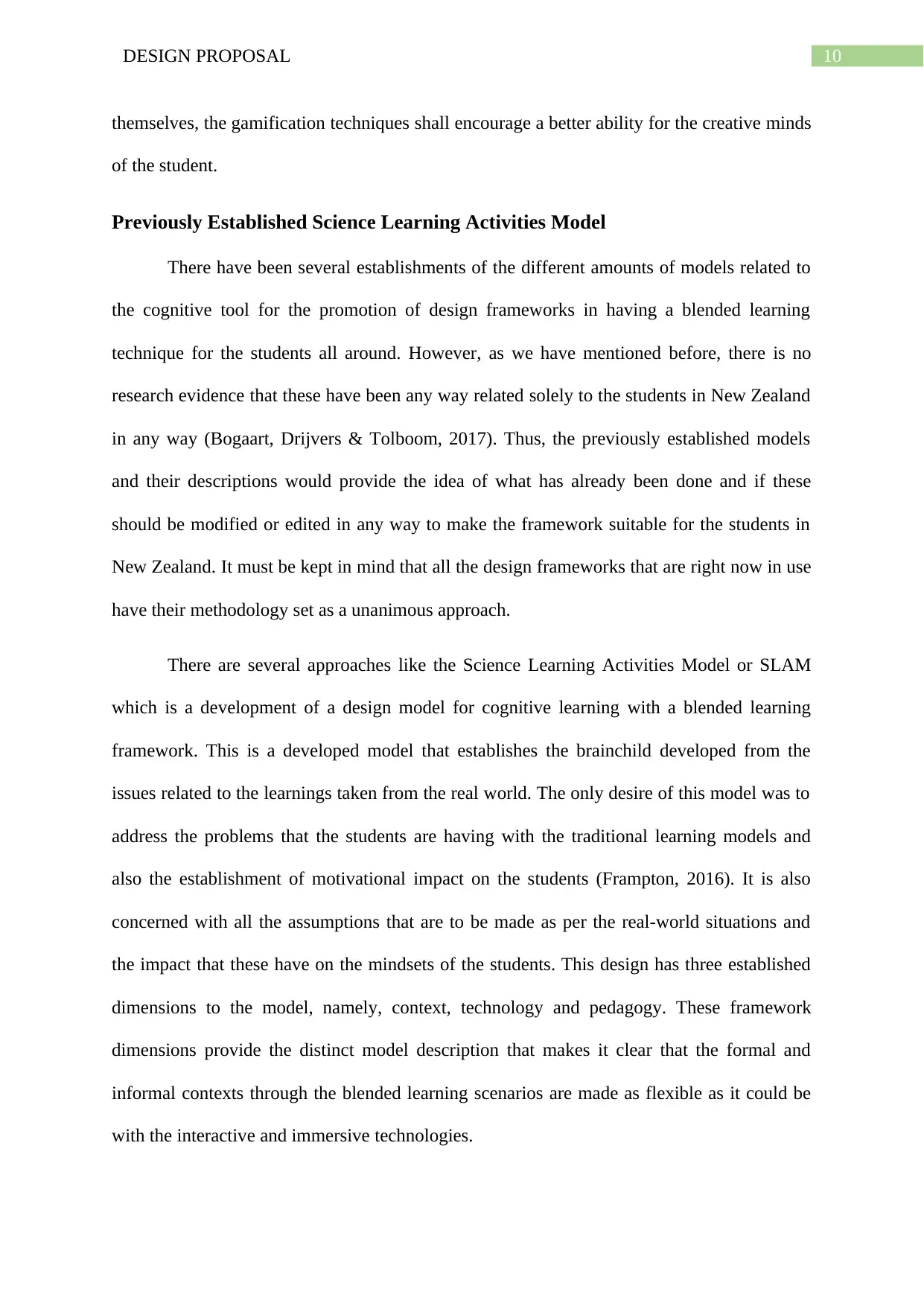
10DESIGN PROPOSAL
themselves, the gamification techniques shall encourage a better ability for the creative minds
of the student.
Previously Established Science Learning Activities Model
There have been several establishments of the different amounts of models related to
the cognitive tool for the promotion of design frameworks in having a blended learning
technique for the students all around. However, as we have mentioned before, there is no
research evidence that these have been any way related solely to the students in New Zealand
in any way (Bogaart, Drijvers & Tolboom, 2017). Thus, the previously established models
and their descriptions would provide the idea of what has already been done and if these
should be modified or edited in any way to make the framework suitable for the students in
New Zealand. It must be kept in mind that all the design frameworks that are right now in use
have their methodology set as a unanimous approach.
There are several approaches like the Science Learning Activities Model or SLAM
which is a development of a design model for cognitive learning with a blended learning
framework. This is a developed model that establishes the brainchild developed from the
issues related to the learnings taken from the real world. The only desire of this model was to
address the problems that the students are having with the traditional learning models and
also the establishment of motivational impact on the students (Frampton, 2016). It is also
concerned with all the assumptions that are to be made as per the real-world situations and
the impact that these have on the mindsets of the students. This design has three established
dimensions to the model, namely, context, technology and pedagogy. These framework
dimensions provide the distinct model description that makes it clear that the formal and
informal contexts through the blended learning scenarios are made as flexible as it could be
with the interactive and immersive technologies.
themselves, the gamification techniques shall encourage a better ability for the creative minds
of the student.
Previously Established Science Learning Activities Model
There have been several establishments of the different amounts of models related to
the cognitive tool for the promotion of design frameworks in having a blended learning
technique for the students all around. However, as we have mentioned before, there is no
research evidence that these have been any way related solely to the students in New Zealand
in any way (Bogaart, Drijvers & Tolboom, 2017). Thus, the previously established models
and their descriptions would provide the idea of what has already been done and if these
should be modified or edited in any way to make the framework suitable for the students in
New Zealand. It must be kept in mind that all the design frameworks that are right now in use
have their methodology set as a unanimous approach.
There are several approaches like the Science Learning Activities Model or SLAM
which is a development of a design model for cognitive learning with a blended learning
framework. This is a developed model that establishes the brainchild developed from the
issues related to the learnings taken from the real world. The only desire of this model was to
address the problems that the students are having with the traditional learning models and
also the establishment of motivational impact on the students (Frampton, 2016). It is also
concerned with all the assumptions that are to be made as per the real-world situations and
the impact that these have on the mindsets of the students. This design has three established
dimensions to the model, namely, context, technology and pedagogy. These framework
dimensions provide the distinct model description that makes it clear that the formal and
informal contexts through the blended learning scenarios are made as flexible as it could be
with the interactive and immersive technologies.
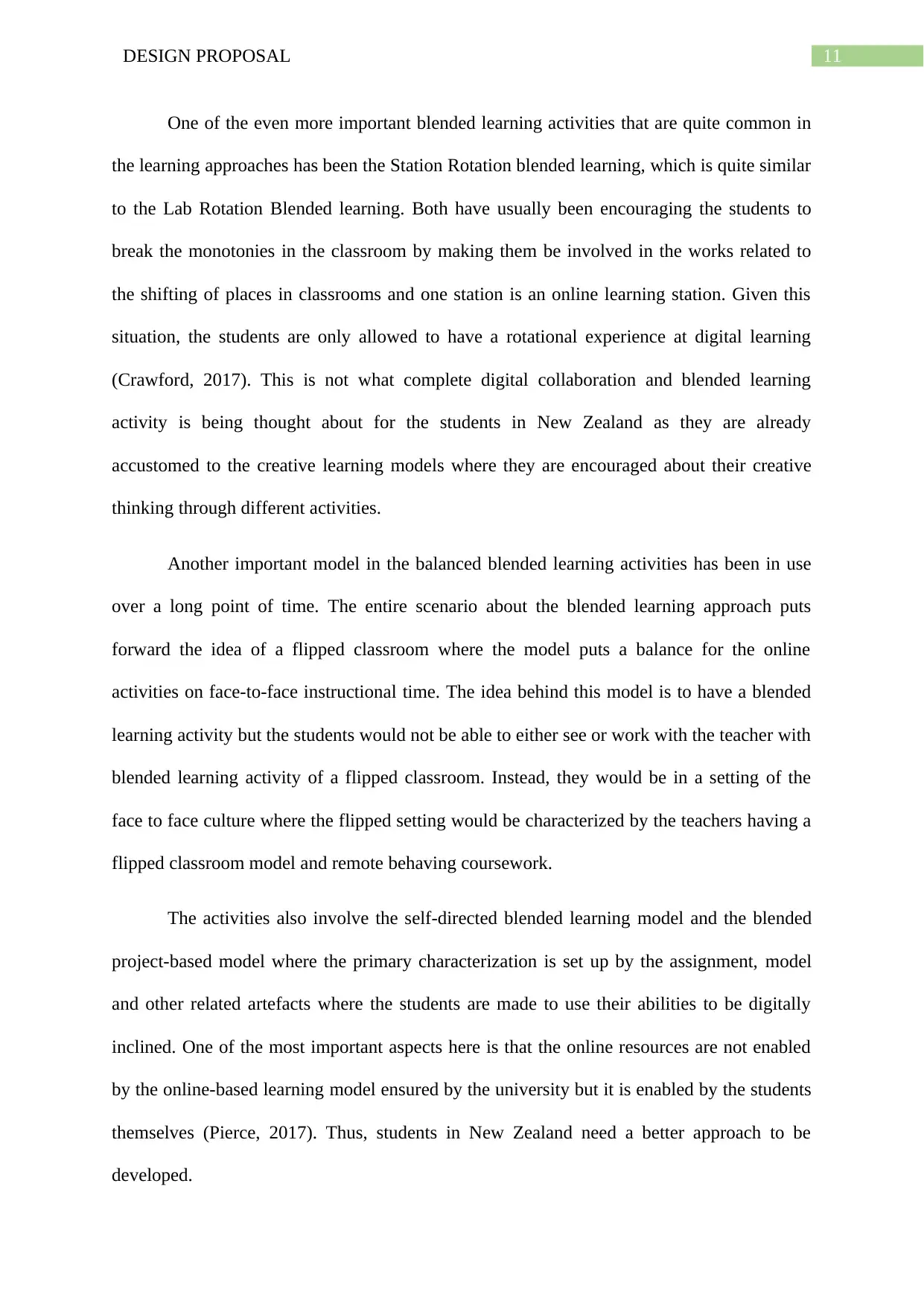
11DESIGN PROPOSAL
One of the even more important blended learning activities that are quite common in
the learning approaches has been the Station Rotation blended learning, which is quite similar
to the Lab Rotation Blended learning. Both have usually been encouraging the students to
break the monotonies in the classroom by making them be involved in the works related to
the shifting of places in classrooms and one station is an online learning station. Given this
situation, the students are only allowed to have a rotational experience at digital learning
(Crawford, 2017). This is not what complete digital collaboration and blended learning
activity is being thought about for the students in New Zealand as they are already
accustomed to the creative learning models where they are encouraged about their creative
thinking through different activities.
Another important model in the balanced blended learning activities has been in use
over a long point of time. The entire scenario about the blended learning approach puts
forward the idea of a flipped classroom where the model puts a balance for the online
activities on face-to-face instructional time. The idea behind this model is to have a blended
learning activity but the students would not be able to either see or work with the teacher with
blended learning activity of a flipped classroom. Instead, they would be in a setting of the
face to face culture where the flipped setting would be characterized by the teachers having a
flipped classroom model and remote behaving coursework.
The activities also involve the self-directed blended learning model and the blended
project-based model where the primary characterization is set up by the assignment, model
and other related artefacts where the students are made to use their abilities to be digitally
inclined. One of the most important aspects here is that the online resources are not enabled
by the online-based learning model ensured by the university but it is enabled by the students
themselves (Pierce, 2017). Thus, students in New Zealand need a better approach to be
developed.
One of the even more important blended learning activities that are quite common in
the learning approaches has been the Station Rotation blended learning, which is quite similar
to the Lab Rotation Blended learning. Both have usually been encouraging the students to
break the monotonies in the classroom by making them be involved in the works related to
the shifting of places in classrooms and one station is an online learning station. Given this
situation, the students are only allowed to have a rotational experience at digital learning
(Crawford, 2017). This is not what complete digital collaboration and blended learning
activity is being thought about for the students in New Zealand as they are already
accustomed to the creative learning models where they are encouraged about their creative
thinking through different activities.
Another important model in the balanced blended learning activities has been in use
over a long point of time. The entire scenario about the blended learning approach puts
forward the idea of a flipped classroom where the model puts a balance for the online
activities on face-to-face instructional time. The idea behind this model is to have a blended
learning activity but the students would not be able to either see or work with the teacher with
blended learning activity of a flipped classroom. Instead, they would be in a setting of the
face to face culture where the flipped setting would be characterized by the teachers having a
flipped classroom model and remote behaving coursework.
The activities also involve the self-directed blended learning model and the blended
project-based model where the primary characterization is set up by the assignment, model
and other related artefacts where the students are made to use their abilities to be digitally
inclined. One of the most important aspects here is that the online resources are not enabled
by the online-based learning model ensured by the university but it is enabled by the students
themselves (Pierce, 2017). Thus, students in New Zealand need a better approach to be
developed.
⊘ This is a preview!⊘
Do you want full access?
Subscribe today to unlock all pages.

Trusted by 1+ million students worldwide
1 out of 25
Related Documents
Your All-in-One AI-Powered Toolkit for Academic Success.
+13062052269
info@desklib.com
Available 24*7 on WhatsApp / Email
![[object Object]](/_next/static/media/star-bottom.7253800d.svg)
Unlock your academic potential
Copyright © 2020–2025 A2Z Services. All Rights Reserved. Developed and managed by ZUCOL.





